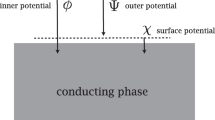Abstract
Heat capacity data for the solid chemical elements and for 10 amino acids from proteins, and Kopp's Law heat capacity values for the chemical elements, show that proteins have extremely low heat capacities compared to other substances. The type of quantum-mechanical interaction that is highly predominant in low-heat-capacity substances reveals the quantum wave properties of matter. Therefore, the quantum-mechanical wave properties of matter are highly predominant in proteins. Some speculations about the meaning of this result are examined and assessed.
Similar content being viewed by others
References
Walsh, E.: Introduction to Biochemistry, Macmillan, New York, 1961, pp. 1–25.
Kelley, K. K. and King, E. G.: Contributions to the data on theoretical metallurgy XIV. Entropies of the elements and inorganic compounds, U.S. Bureau of Mines Bull. 592, (1961), 101–117.
Cochran, A. A.: Life and the wave properties of matter, Dialectica, Internat. Rev. Philos. Knowledge 19 (3/4), (1965), 290–312.
Hix, C. and Alley, R.: Physical Laws and Effects, Wiley, New York, 1958, pp. 42–3.
MacDougall, F.: Physical Chemistry, Macmillan, New York, 1936, pp. 120–121.
Huffman, H. and Ellis, E.: J. Amer. Chem. Soc. 59 (1937), 2150.
Rossini, F., Wagman, D., Evans, W., Levine, S., and Jaffe, I.: Selected values of chemical thermodynamic properties, NBS Circ. 500, U.S. Dept. of Commerce, 1952.
Huffman, H. and Fox, S., J. Amer. Chem. Soc. 62 (1940), 3464.
Huffman, H. and Borsook, H.: J. Amer. Chem. Soc. 54 (1932), 4297.
Huffman, H. and Ellis, E.: J. Amer. Chem. Soc. 57 (1935), 46.
Bohm, D.: Quantum Theory, Prentice-Hall, New York, 1951, pp. 94–95, 104–111, 118–120.
Cochran, A. A.: The quantum physical basis of life, Main Currents in Modern Thought 13 (5) (1957), 99–104.
Mendelssohn, K.: Superfluids, Science 127 (3292) (1958), 215–221.
Cochran, A. A.: The Application of Quantum-Mechanical Concepts To Biological Systems, Thesis T 1484, Univ. of Missouri-Rolla, 1963.
Cochran, A. A.: Mind, matter, and quanta, Main Currents in Modern Thought 22 (4) (1966), 79–88.
Cochran, A. A.: Relationships between quantum physics and biology, Found. Phys. 1 (3) (1971), 235–250.
Witmer, E. E.: Interpretation of quantum mechanics and the future of physics, Amer. J. Phys. 35 (1967), 40–52.
Miller, D. A.: Biological systems and the rumored animate-sentient like aspect of physical phenomena, J. Biol. Phys. 17 (1990), 145–150.
Author information
Authors and Affiliations
Rights and permissions
About this article
Cite this article
Cochran, A.A. Living organisms and the quantum-mechanical wave properties of matter. Journal of Biological Physics 18, 11–17 (1991). https://doi.org/10.1007/BF00383786
Received:
Issue Date:
DOI: https://doi.org/10.1007/BF00383786




